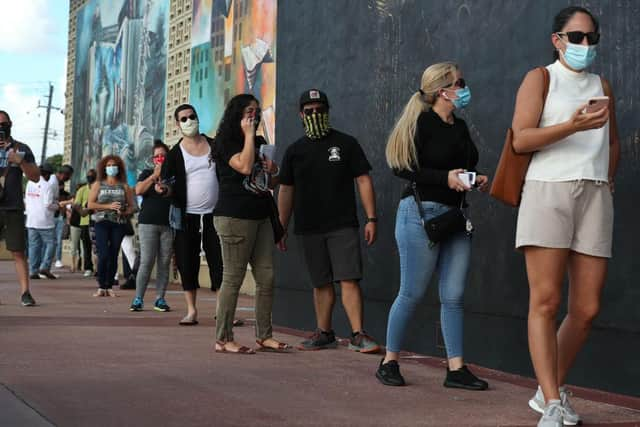US election voter turnout: how many people are expected to vote in 2020 compared to 2016 - and voting eligible population explained
Americans are turning out in high numbers to vote in the 2020 US Election, with over 99 million citizens already casting their ballot ahead of election day.
The high uptake in early voting is partly due to a desire from voters to avoid crowded polling places on voting day, with the country still in the grips of the coronavirus pandemic.
Advertisement
Hide AdAdvertisement
Hide AdBut the signs are that the United States could be set for its highest turnout in over a century, with forecasts suggesting that well over 60% of the eligible voting population will cast their vote, eclipsing the total in 2016.


What is the US voting population?
While the US’ population is around 380 million people, not all of them are eligible to vote.
In the US, non-citizens, some people with felonies and people who are mentally incapacitated are barred from voting
You must be 18 or older on election day, and be registered to vote, in order to cast a vote in the presidential election.
While there is no exact figure for how many people are eligible to vote in the upcoming election, the number of people who are eligible has grown in recent years, peaking at 233.7million in 2018.
What was voter turnout in 2016?
In 2016, 138,847,000 votes were cast, representing some 60.1% of the voting eligible population, according to the United States Elections Project.
This was an increase on the voting turnout in 2012 when 58.6% of the VEP turned out, electing Barack Obama for the second time.
Four years earlier, turnout among the VEP eclipsed the two most recent elections with 61.65% of the VEP heading to the polls, electing Obama for his first term in office.
Advertisement
Hide AdAdvertisement
Hide AdPresident Obama’s first victory saw the highest turnout among the VEP in the past 50 years.
Which states had the highest voter turnout in 2016?
In 2016, turnout was highest on a state level in Minnesota, where 74.8% of the VEP turned out to vote.
Maine (72.8%), New Hampshire (72.5%) and Colorado (72.1%) were second, third and fourth respectively.
Wisconsin, where Mr Trump claimed one of his most unlikely victories on election night in 2016, had a VEP turnout of 70.5%.
Hawaii recorded the lowest turnout with just 43% of the VEP turning out to vote, while West Virginia recorded just 50.8%.
Texas, known for historically low turnout, had a turnout of just 51.6%.
Trump secured key victories in Michigan and Florida which both saw turnouts of 65.7%, while Ohio, the site of another key Republican triumph, saw turnout of 64.2%.
What’s the expected turnout in 2020?
Early signs suggest that 2020 will see a higher turnout than last election, though this should be treated with caution due to the exceptional circumstances caused by the coronavirus pandemic.
Advertisement
Hide AdAdvertisement
Hide AdAccording to the U.S. Elections Project at the University of Florida, over 99m Americans have already cast their vote, with turnout predicted to be the highest since the 1908 election.
Remarkably, the number of mail-in ballots cast in Hawaii has already exceeded its entire turnout in 2016.
Texas is also forecast to eclipse its 2016 turnout prior to election day, with 9.6m votes cast in the state as of October 31.
Data from the US Elections Project suggests that 150m Americans could cast their vote this year – 12m more than the vote in 2016.
Why are more people voting?
More than ever the electorate feel like the result of the election matters – a poll by Pew Research Center found that 83% of respondents believed that it “really matters who wins” the election, compared to 74% in 2016 and 63% in 2012.
This is at least partly to do with Mr Trump’s divisive nature, with his loyal base and his bitter rivals determined to emerge victorious this election day following a year dominated by the coronavirus pandemic and Black Lives Matter demonstrations.
How does US turnout compare to the UK?
Turnout at UK elections tends to be over 65%.
At the 2019 general election turnout was 67.3%, while in 2017 turnout was higher still at 68.8%.
In 2015 turnout was slightly lower, with 66.4% of eligible voters sending David Cameron into Number Ten Downing Street.